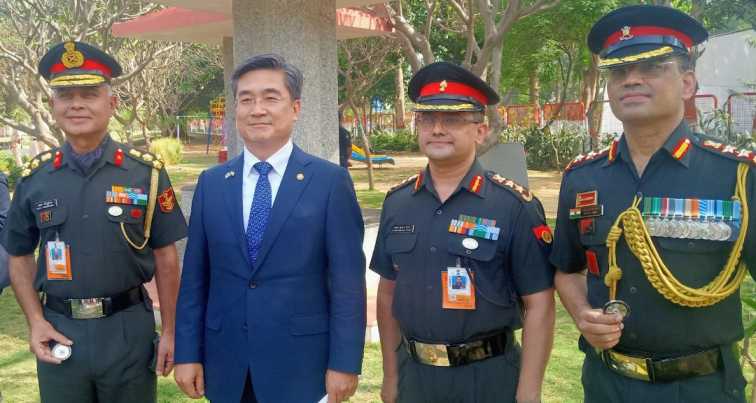Indo-Korean Friendship Park, a landmark for visiting Korean delegates, tourists
This is in addition to Queen Huh Hwang-ok Memorial Park coming up in Ayodhya, UP where a score of Korean delegates visit every year.
NEW DELHI: With the inauguration of India’s First Indo-Korean Friendship Park by Suh Wook, Minister of National Defence, Republic of Korea, and his counterpart Rajnath Singh, at Delhi Cantonment on Friday morning, India has added a landmark for the Korean delegates and tourists visiting India.
From now on, the Korean delegates and tourists visiting India would be able to visit this park that reminds of the deep historical connection between India and South Korea.
This park is in addition to the Queen Huh Hwang-ok Memorial Park coming up in Ayodhya, Uttar Pradesh. A score of Korean delegates visit this park every year in memory of the Indian Princess Suriratna who had traveled to Korea 2000 years back, and married King Kim Suro, and had become Queen Huh.
Located in Delhi Cantonment, the Indo-Korean Friendship Park’s significance is not only because of it being a symbol of strong India-South Korea friendly relations but also as a monument to India’s contributions as part of 21 countries that participated in the Korean war 1950-53, under the aegis of the United Nations.
The presence of distinguished guests from the Korean War Veterans Association during the inauguration ceremony was an acknowledgment of the event. Both the Ministers planted a sapling each to mark the momentous occasion. Suh Wook felicitated the Korean War Veterans Association of India General Secretary Anil Malhotra on the occasion.
The delegation from the Korean Embassy in India including Shin Bong-kill, Ambassador, Yongsoo Lee, Minister & Deputy Head of Mission, Jong-ho Choi, Minister, Embassy of Korea, Col. Lee In, Defence Attache were present on the occasion.
Euy Don Park, President of the Korean Federation in India was also present during the inauguration ceremony on Friday.

The Korean defence minister Suh Wook also presented medallions to Brig Ajay Chandpuria – India’s first Defence Attache to Korea, and Col Rakesh Mishra, Defence Attache of India in the Republic of Korea.
The park has been developed in joint consultation with the Ministry of Defence, the Government of India, the Indian Army, the Delhi Cantonment Board, the Embassy of Korea, and the Korean War Veterans Association of India.
Spread across a green area of six acres, the park includes an entrance gate beautifully made in Korean style signifying the graceful culture, a jogging track, a well-landscaped garden, and an amphitheater.
The park has an imposing handshake artifact standing tall at the entrance bearing flags of India and South Korea which was unveiled by Suh Wook, Minister of National Defence, Republic of Korea, and Rajnath Singh.
The park also has a larger-than-life statue of General KS Thimayya, a celebrated soldier who led the Indian contingent as Chairman of Neutral Nations Repatriation Commission (NNRC) in Korea headed by India.
The commission, through the Custodian Force of India (CFI), was responsible for gathering unrepatriated prisoners of war into camps which were also India’s first commitment to a UN assignment after independence. The five pillars raised in the backdrop of General Thimayya’s statue are embossed with details of operations carried out by 60 Parachute Field Ambulance during the Korean war where they had treated about 1,95,000 cases and performed about 2,300 field surgeries.
One pillar also encompasses Nobel Laureate Gurudev Rabindranath Tagore’s narration of Korea as “The Lamp of the East” which was published in Korean daily “Dong-A-llbo” in 1929.



